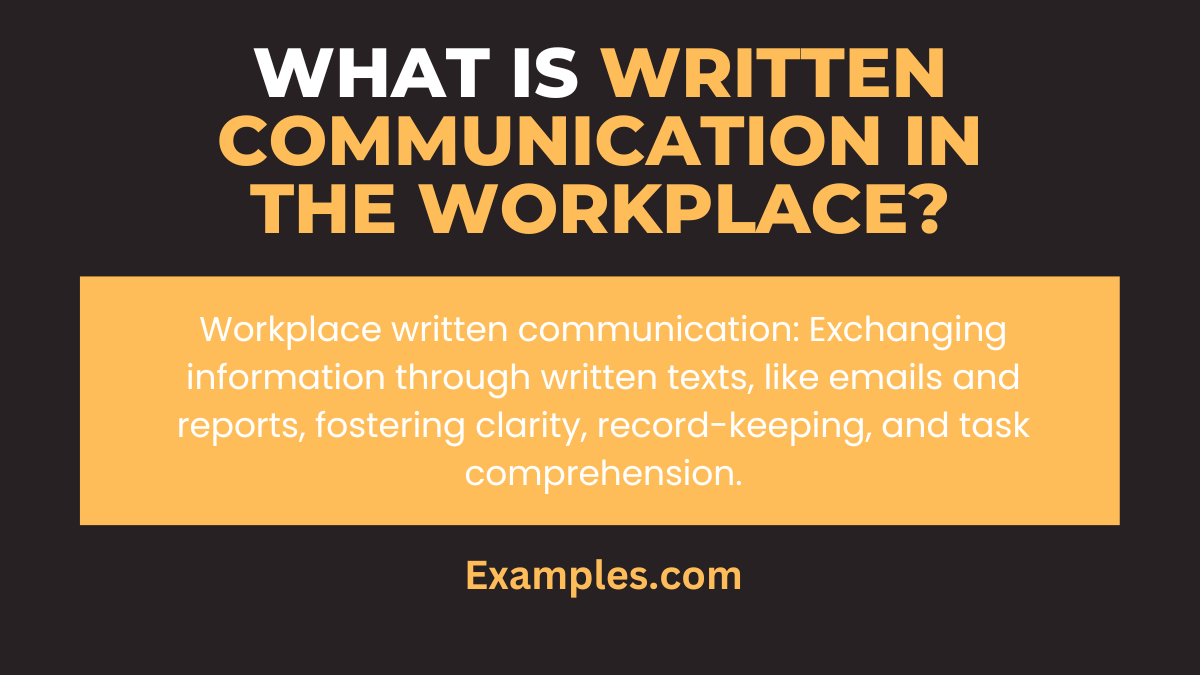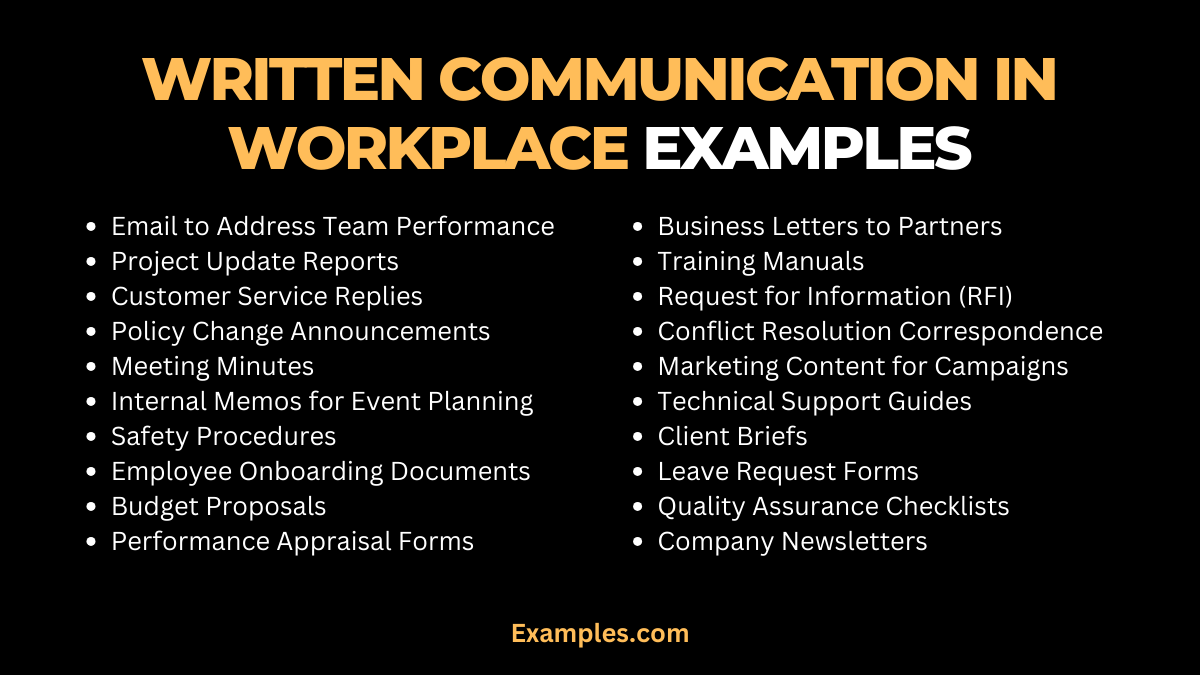19+ Written Communication in Workplace Examples
Explore the comprehensive world of Written Communication in the Workplace through this guide, featuring real-world Communication Examples. Understand how effective writing can streamline processes, enhance productivity, and foster a positive work environment. This guide, enriched with Written Communication Examples, will illustrate the Importance of Written Communication in maintaining clarity, efficiency, and professionalism in all business interactions.
What is Written Communication in the Workplace? – Meaning

Written communication in the workplace involves the exchange of information or ideas through written texts. This includes emails, reports, memos, and more. Effective written communication is key in business environments as it provides a record of discussions and agreements, ensuring everyone has a clear understanding of tasks and expectations.
What is the Best Example of Written Communication in Workplace?

One of the best examples of written communication in the workplace is a well-structured, clear, and concise email. A perfectly crafted email provides direct information, leaves no room for misunderstanding, and calls for specific action. For instance, an email detailing project milestones, deadlines, and individual responsibilities helps keep the team on track and accountable, illustrating the power of written communication in enhancing organizational efficiency and clarity.
20 Written Communication in Workplace Examples

Discover the nuances of Written Communication in the Workplace through 20 distinct examples. Each illustrates the Characteristics of Written Communication, complete with Written Communication Sentence Examples and entries from a Written Communication Journal. These examples showcase various scenarios, highlighting common pitfalls and offering solutions to enhance clarity, effectiveness, and professional rapport in the workplace. Dive into each scenario to learn what causes communication breakdowns and how to rectify them for improved workplace communication.
- Email to Address Team Performance: Poorly written emails may cause demotivation. Clarify goals and provide constructive feedback to maintain morale and clarity.
- Project Update Reports: Vague updates can lead to project mismanagement. Use specific data and clear language to convey accurate project status.
- Customer Service Replies: Ambiguous responses can escalate issues. Use empathetic, clear language to provide solutions and maintain customer relationships.
- Policy Change Announcements: Confusion over policies disrupts compliance. Detail changes and reasons to ensure understanding and adherence.
- Meeting Minutes: Inaccurate minutes can mislead future discussions. Record discussions and decisions precisely to serve as a reliable record.
- Internal Memos for Event Planning: Misinformation can lead to poor event execution. Provide detailed, structured plans to coordinate effectively.
- Safety Procedures: Ambiguity in safety instructions can lead to accidents. Use clear, imperative sentences to ensure understanding and compliance.
- Employee Onboarding Documents: Incomplete onboarding can affect performance. Outline expectations and resources clearly for a smooth transition.
- Budget Proposals: Unclear proposals may lead to incorrect resource allocation. Itemize and explain budget needs for accurate financial planning.
- Performance Appraisal Forms: Generic or vague appraisals don’t guide improvement. Offer specific feedback and goals for employee development.
- Business Letters to Partners: Misunderstandings can strain relationships. Use formal, precise language to communicate effectively with business partners.
- Training Manuals: Ineffective training leads to errors. Use simple, instructive language with examples for better skill acquisition.
- Request for Information (RFI): Incomplete RFIs delay decision-making. Be explicit about information needed for quick, accurate responses.
- Conflict Resolution Correspondence: Poorly managed conflicts affect morale. Address issues directly and propose solutions to resolve disputes effectively.
- Marketing Content for Campaigns: Unclear content won’t engage customers. Craft compelling, clear messages to attract and retain interest.
- Technical Support Guides: Complex jargon confuses users. Explain solutions in layman’s terms for effective problem-solving.
- Client Briefs: Ambiguities can lead to unsatisfied clients. Detail client needs and project steps for successful outcomes.
- Leave Request Forms: Inconsistent leave policies create staffing challenges. Standardize forms with clear instructions for smooth processing.
- Quality Assurance Checklists: Overlooking details affects product quality. List specific criteria clearly for consistent quality checks.
- Company Newsletters: Disengaged employees miss important news. Write engaging, informative content to keep staff updated and involved.
Download Written communication in workplace FAQs PDF
Written Communication in Workplace for Employees
Effective Written Communication in Workplace for Employees is essential for clarity, productivity, and ensuring a smooth workflow. Especially in sectors like Written Communication in Nursing and Written Communication in Healthcare, where accurate information can be a matter of life and death, mastering written communication is non-negotiable. Discover five examples of how employees can improve their written communication, with specific strategies and sentence examples to illustrate each point.
- Incident Reports in Nursing: Nurses must communicate patient incidents clearly. “Patient displayed symptoms X and Y; immediate action taken was Z.” Ensure all relevant details are concise and clear.
- Shift Change Notes: Clear communication during shift changes prevents errors. “Completed patient rounds; note changes in patient A’s medication schedule.” Be detailed to ensure seamless care transition.
- Patient Education Materials: Provide understandable health guides. “To manage condition X, please do Y. For more information, visit Z.” Simplify medical jargon for patient comprehension.
- Medical Record Documentation: Accurate records are vital. “Patient diagnosed with X; treatment initiated on Y date; follow-up needed by Z.” Detail every aspect of patient care.
- Healthcare Policy Updates: Keep staff informed of changes. “Effective immediately: new protocol for X. Please review and implement accordingly.” Communicate changes directly and ensure understanding.
How can Written Communication be Effective in the Workplace?
Effective written communication is as crucial in the workplace as it is in Written Communication in Schools. It ensures that messages are clear, tasks are understood, and there is a solid record of exchanges. Here are five steps to enhance written communication:
- Clear and Concise Language: Use straightforward language to avoid misunderstandings and ensure the message is understood by all employees.
- Proper Structure and Format: Organize information logically with headings, bullet points, and numbered lists for easy reading and understanding.
- Regular Updates and Feedback: Keep documents like project plans and team updates current and solicit feedback for continuous improvement.
- Tailored Content for Audience: Understand the recipient’s knowledge level and needs, ensuring the message is appropriate for their role and experience.
- Proofreading and Reviewing: Eliminate errors and unclear phrasing by thoroughly checking all written communication before sending.
How Does Written Communication Impact Day-to-day Operations in the Workplace?
Just like Written Communication in Education shapes learning, written communication structures and directs daily operations in the workplace. Here are five ways it impacts daily activities:
- Guides Task Execution: Clear instructions and guidelines help employees understand their tasks and how to execute them effectively.
- Facilitates Record Keeping: Documentation provides a historical record of decisions, discussions, and actions, crucial for accountability and reference.
- Supports Decision Making: Well-presented data and reports help managers and teams make informed decisions.
- Enhances Collaboration: Shared documents and written updates promote teamwork, even when team members are not physically together.
- Ensures Compliance: Properly written policies and procedures ensure that all actions are compliant with laws and regulations.
When to Use Written Communication in the Workplace?
In the workplace, similar to Written Communication in the Classroom, there are specific times when written communication is more appropriate or necessary. Here are five situations:
- Documenting Formal Agreements: Use written contracts and agreements to ensure all parties have a clear, enforceable understanding of terms.
- Providing Detailed Instructions: When tasks are complex or need to be referred to later, written instructions or guidelines are essential.
- Announcing Policy Changes: Written notices ensure that all employees are informed of new policies or changes to existing ones.
- Giving Performance Feedback: Written evaluations provide employees with clear, actionable feedback that they can refer back to.
- Handling Sensitive Information: When dealing with confidential or sensitive matters, written communication provides a secure and private medium.
Activities to Improve Communication Skills in the Workplace
Enhancing communication skills in the workplace involves several activities aimed at fostering effective interaction among team members. Encouraging open dialogue, active listening, and constructive feedback cultivates strong communication skills. Promoting workshops and training sessions, inspired by Communication Skills for Students, equips employees with essential tools for collaboration and problem-solving. These activities foster a culture of Teamwork Communication, where individuals communicate efficiently, leading to improved productivity and harmonious work environments.
What are the Main Ways of Written Communication at Work?
Emails, reports, memos, and notices are mainstays of workplace written communication, each serving distinct purposes for clarity and record-keeping.
What is the Important Key in Written Communication at Work?
Clarity is the cornerstone of effective written communication at work, ensuring messages are understood and acted upon correctly. Focus on this to improve.
What are the Common Forms of Written Communication used in the Workplace?
Common forms include emails, memos, reports, proposals, and manuals. Each form serves specific purposes, from daily communication to formal documentation.
In conclusion, written communication is the linchpin of workplace efficiency and effectiveness. Through examples, we’ve seen its transformative effects, while recognizing signs of both success and shortcomings. To rectify issues, fostering a culture of clarity, providing training, and utilizing technology wisely are key. It’s a dynamic tool that, when harnessed skillfully, empowers organizations to thrive.



